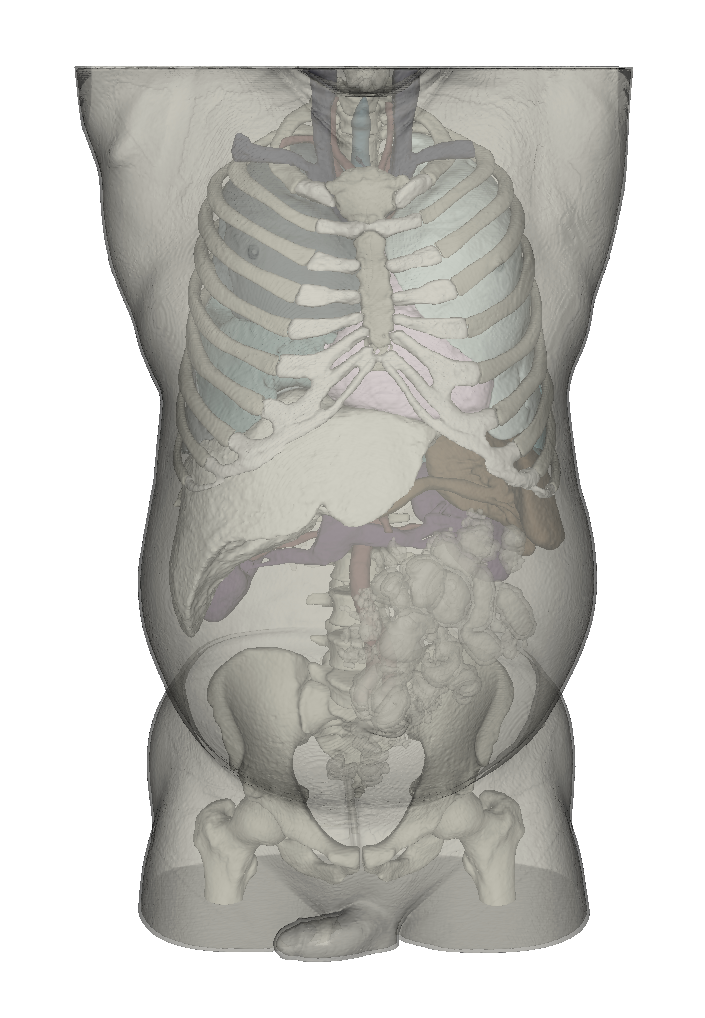Rumpf/en: Unterschied zwischen den Versionen
Becher (Diskussion | Beiträge) (Die Seite wurde neu angelegt: „<!-- -->“) |
Will (Diskussion | Beiträge) |
||
| Zeile 60: | Zeile 60: | ||
The lower part of the trunk is the pelvis. This consists of the two hip bones (Ossa coxae) and contains the internal pelvic organs. | The lower part of the trunk is the pelvis. This consists of the two hip bones (Ossa coxae) and contains the internal pelvic organs. | ||
| − | The abdomen is located between the rib cage (height of the tip of the sternum) and the pelvis (up to the inguinal ligament). Within the abdomen is a fluid-filled cavity - the abdominal cavity or | + | The abdomen is located between the rib cage (height of the tip of the sternum) and the pelvis (up to the inguinal ligament). Within the abdomen is a fluid-filled cavity - the abdominal cavity or abdomen. The diaphragm forms the upper limit of the abdominal cavity. Below it it is bounded by the hip bone and the pelvic floor. |
The back extends from the loin or coccyx to the lower part of the neck. This includes the spine, the rear parts of the ribs and soft tissues such as connective tissue and back muscles. | The back extends from the loin or coccyx to the lower part of the neck. This includes the spine, the rear parts of the ribs and soft tissues such as connective tissue and back muscles. | ||
The thorax is formed by the thoracic spine, the sternum and the ribs. The respiratory musculature attaches itself to the outside and inside of the rib cage. | The thorax is formed by the thoracic spine, the sternum and the ribs. The respiratory musculature attaches itself to the outside and inside of the rib cage. | ||
Version vom 6. November 2020, 08:58 Uhr
The trunk can also be called a torso. It represents the trunk without head and extremities. It contains the bony structures of the trunk skeleton. It is further divided into Thorax, Abdomen, Dorsum and Pelvis. The trunk contains the basic Inner organs, while the abdomen contains the stomach, small and large intestine, spleen, liver, kidneys and pancreas. The chest houses the heart and lungs. The pelvis contains the bladder and sexual organs.
Anatomy
The lower part of the trunk is the pelvis. This consists of the two hip bones (Ossa coxae) and contains the internal pelvic organs. The abdomen is located between the rib cage (height of the tip of the sternum) and the pelvis (up to the inguinal ligament). Within the abdomen is a fluid-filled cavity - the abdominal cavity or abdomen. The diaphragm forms the upper limit of the abdominal cavity. Below it it is bounded by the hip bone and the pelvic floor. The back extends from the loin or coccyx to the lower part of the neck. This includes the spine, the rear parts of the ribs and soft tissues such as connective tissue and back muscles. The thorax is formed by the thoracic spine, the sternum and the ribs. The respiratory musculature attaches itself to the outside and inside of the rib cage.
Function and tasks
The trunk skeleton and the musculature ensure the stability of the upper body. It is only thanks to the bones and muscles in the trunk that walking and standing upright is possible for humans. In addition, almost all important organs of the body are located in the trunk, with the exception of the brain. Most digestive organs such as the stomach, small intestine, large intestine, spleen, pancreas and liver are located in the abdomen. The liver is the body's most important metabolic organ. It is particularly important in processing nutrients and detoxifying the body. The kidneys, also belonging to the abdominal organs, filter the blood and support the excretion of metabolic waste products. A further function is the regulation of blood pressure and water balance. Both the heart and the lungs are located in the chest. The heart is the central organ for the blood circulation. The lungs ensure that the blood is enriched with oxygen. Carbon dioxide is extracted from the blood and breathed out. In the area of the pelvis are the bladder, the draining urinary tract and the genital organs. The urine produced in the kidneys is excreted via the bladder and the urinary tract. The reproductive organs are primarily used for reproduction.
